26 Aug Love Wins: Remembering David Baker
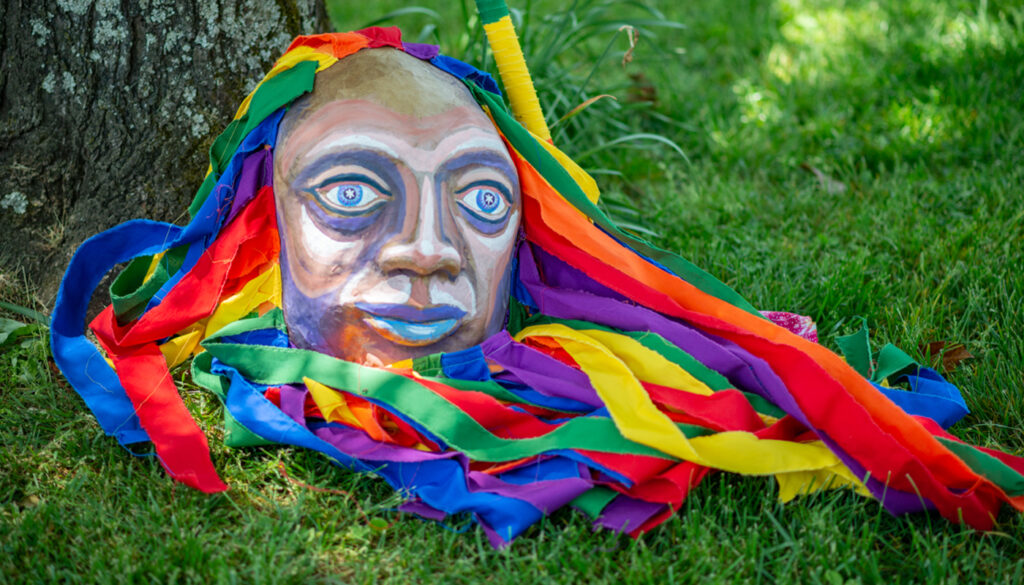
David’s Rainbow Spirit Costume Created for May Day Celebration
The Folk School community lost a bright light with the recent passing of David Baker. David was a longtime Brasstown resident, Folk School kaleidoscopes, glass, & quilting instructor, curious student, massage therapist, and much more to many at the Folk School. David Baker lit up any room with creative energy and joy. You might have seen him in a pink Easter bunny outfit in the spring, dressed as the spirit of fall at Fall Festival, or, on a more casual day, gliding around the Dining Hall in a flouncy, fluorescent tutu. In the spirit of the Folk School, he reminded us to embrace our inner child, to play, to laugh, to create, to experiment and to love each other and ourselves.
We are republishing this interview with David from our archives not only to remember David and his journey. but to carry on the legacy of his philosophy about love, life, and the freedom to be yourself.
Cory Podielski: Where are you from and how did you get here to Brasstown?
David Baker: Wonderful. I was originally from Hickory, North Carolina and my journey took me to Chicago and then to LA. When I was in Los Angeles, I was a nurse at UCLA and I had a premonition one day that something bad was going to happen. I went to the Grand Canyon and that weekend I lost my home in the 1994 Northridge earthquake. I took that as a sign and decided that maybe it was time to go back to North Carolina.
I’d always dreamed of living in a cabin on a mountaintop. I would walk on the beach and see a cabin in my head. I told my family I was returning to NC and my brother, who is a truck driver, would tell me about this beautiful place he wanted to show me. He didn’t know anything about the Folk School, but he just knew this area was beautiful and close to big cities. He sent me a catalog of homes in the Brasstown area and in that catalog was the home–the home that I had actually seen in my dreams!
I knew this was the cabin. When I first came here to look, the realtor took me all around to everywhere but the cabin. Finally, at the end of the day, she took me there and I just knew: “This is it!” It felt like this is where I was supposed to be, so I got the cabin and I moved to Brasstown on May 1, 1994. At that moment, I knew nothing of the Folk School and the things that have become really important in my life today.
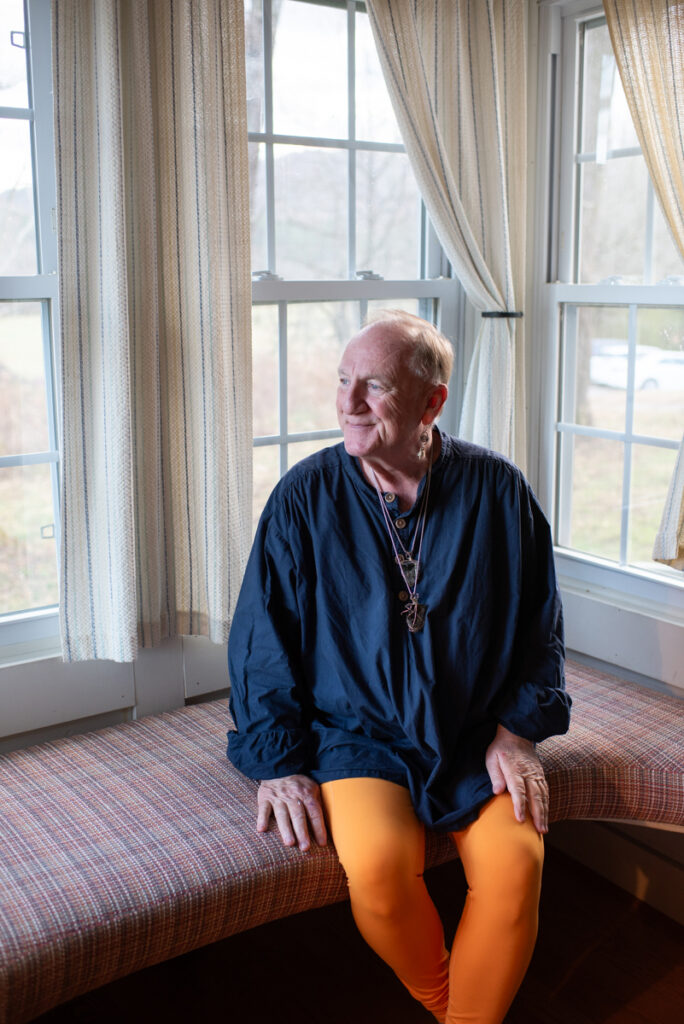
David Baker Taking a Moment in Farmhouse Between Massage Sessions
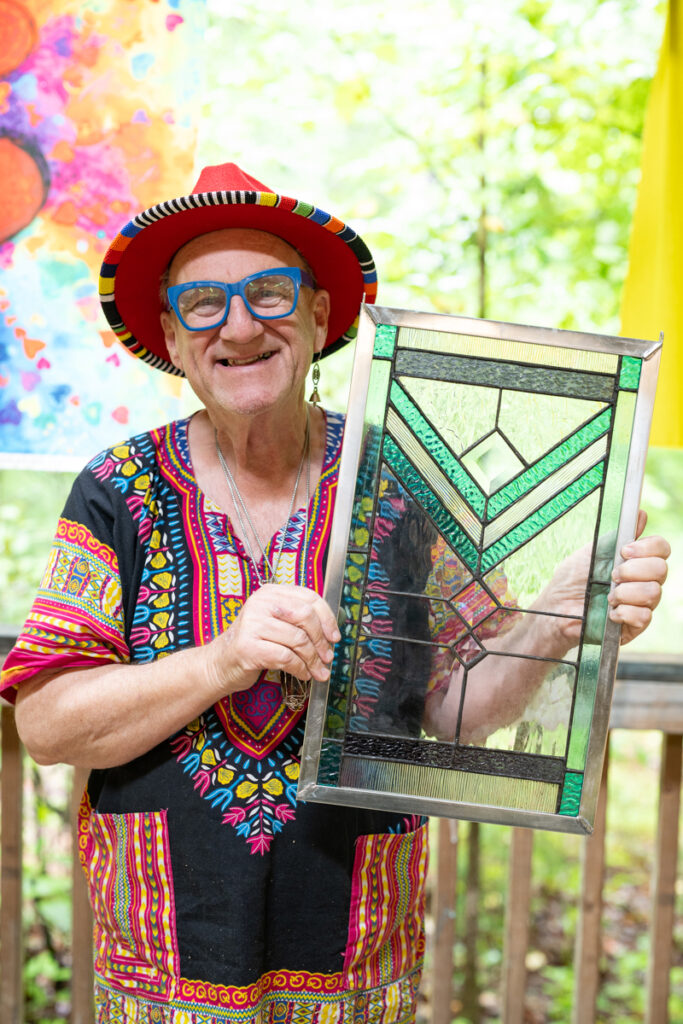
David Holding His Prairie-style Stained Glass Panel on the Jewelry Studio Porch
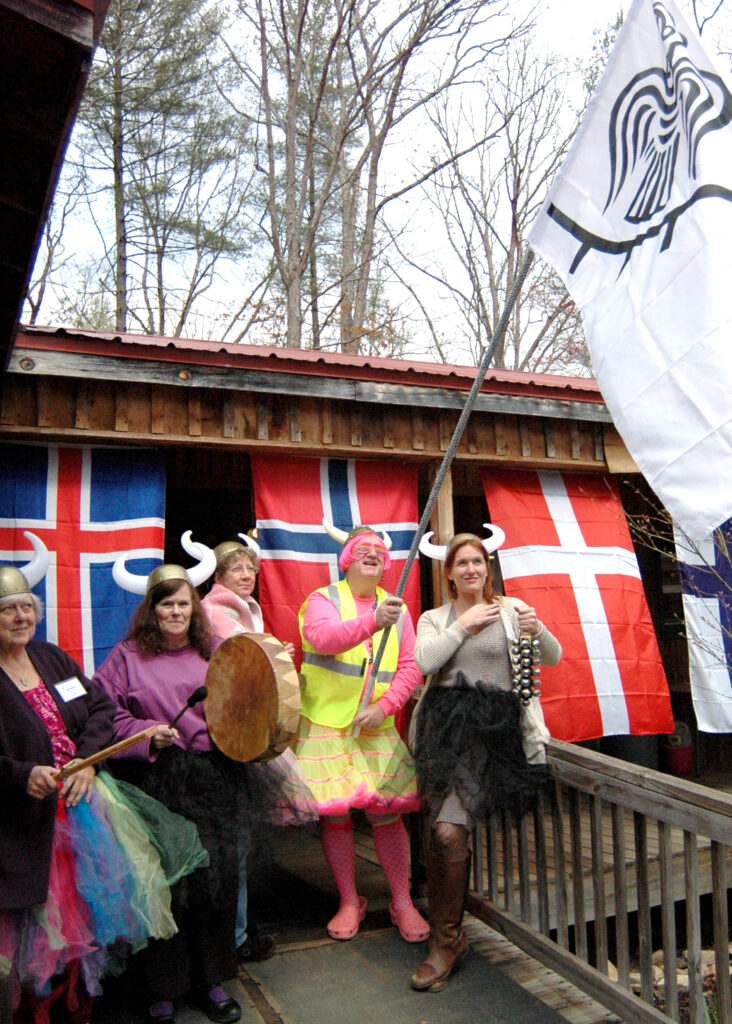
David and his Kaleidoscope Class During Scandinavian Heritage Week
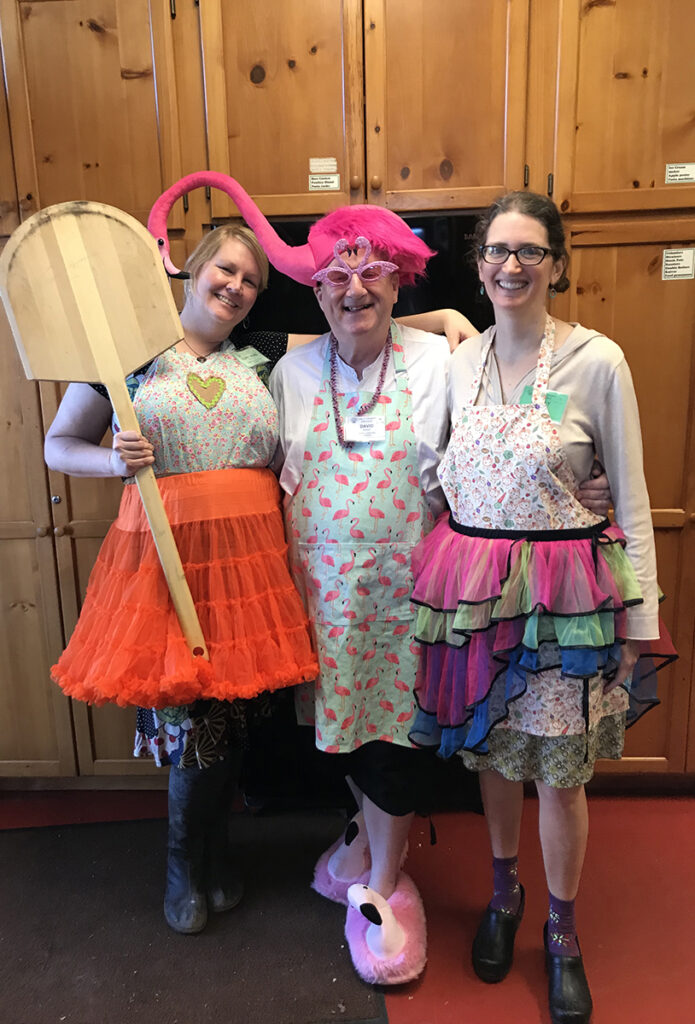
Cory, David, and Emily in “The Science of Bread” Class
CP: Where did your journey begin with the Folk School?
DB: Ah, in all truth it began because the first two years I lived here, I had a neighbor who really did not like me. Every morning he would scream horrible things and would shoot a gun when I would be trying to enjoy my life. This went on and on, and nothing seemed to happen with the sheriff since it was on private land. Eventually, one of the deputies told me to film him and I did. He was taken to court and charges were filed, and it was one of the worst times of my life. It might have been worse than the earthquake.
Anyhow, there was an article in the paper about it and I got a phone call from the wonderful artists Lee Davis and Doug. They contacted me and said, “We’re so proud of you, we want you to know that we read that article in the paper. We think you are very brave and we want you to come over for a dinner party.” We became good friends, and one day they said, “Don’t you love art?” Lee is a potter and Doug worked in the Folk School Craft Shop at the time. I said, “I love art!” They then asked me, “Why don’t you do something you really love? What have you always loved to do?” I said, “I really love stained-glass.” And they replied, “Then that’s what you do!”
That’s how I started my journey with glass. I first took a glass class at Tri-County Community College and then I studied with Judson Bailey who used to teach at the Folk School. He had a little shop in downtown Brasstown and I studied as an apprentice with him for a year. I used to say to him, I want to make a kaleidoscope.” He’d reply, “I don’t know anything about making a kaleidoscope,” so I took a kaleidoscope class here at the Folk School and that made me very happy.
I went back to my studio and made a scope on my own, just for me. Somebody in the community came and bought it and then I got a phone call after asking if I would teach that at the Folk School. So, that’s how I came to the Folk School in a long round-about way. But everything works like that in my life, it just sort of unfolds. That’s when I started teaching, about around the year 2000.
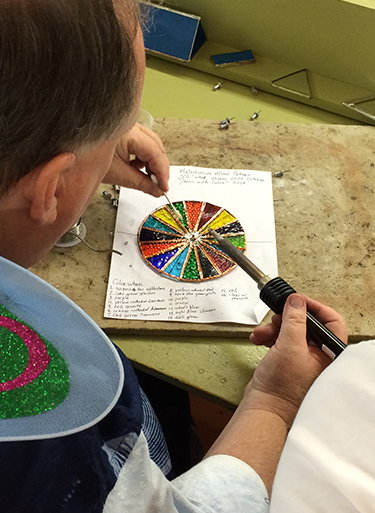
David Creating a Kaleidoscope
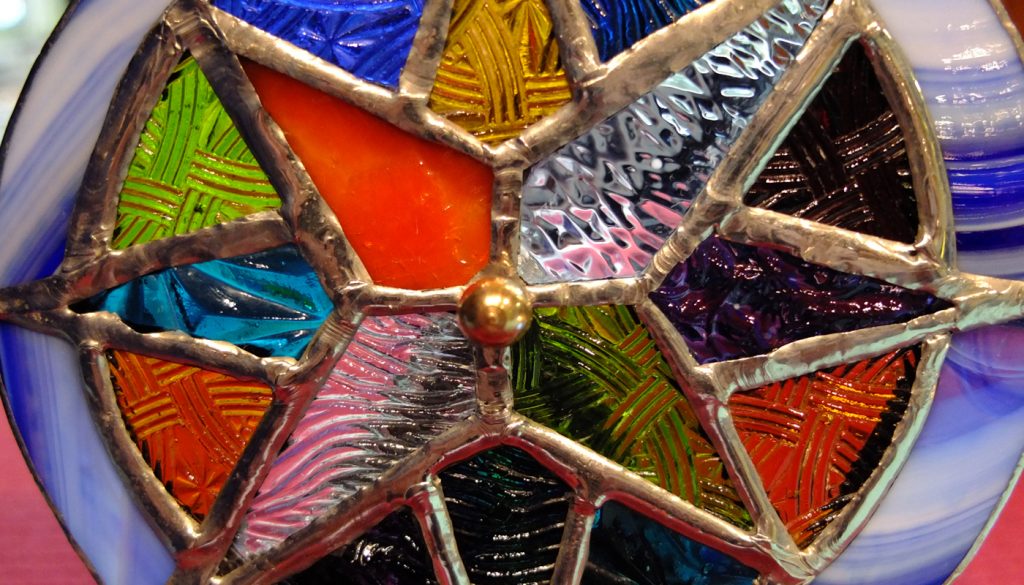
Kaleidoscope Close Up
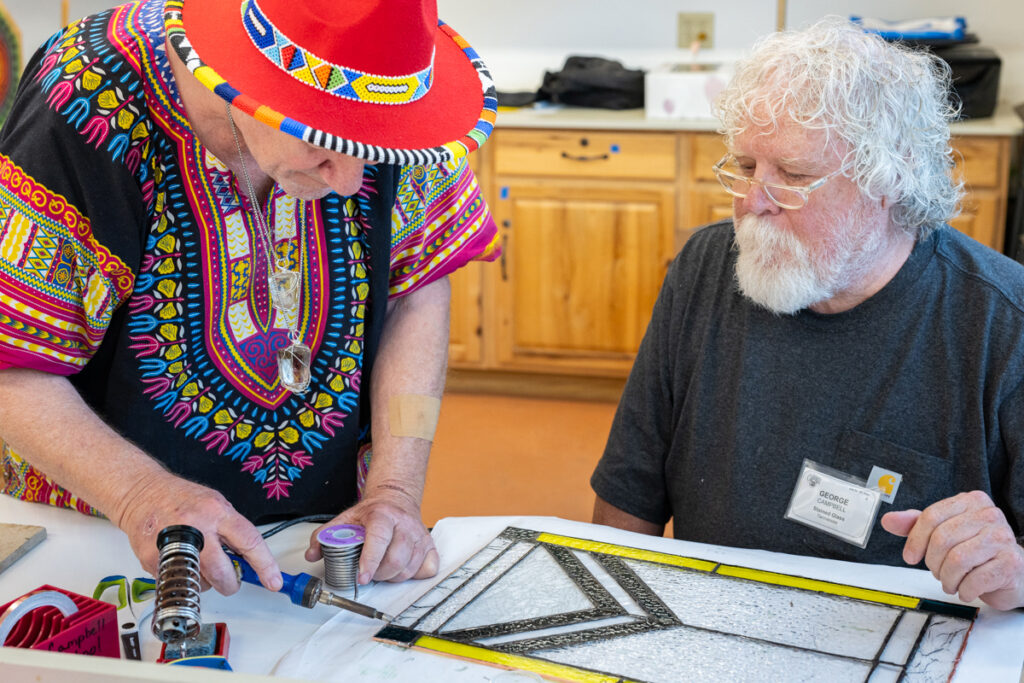
David Teaching Stained Glass

Student Looking into Kaleidscope
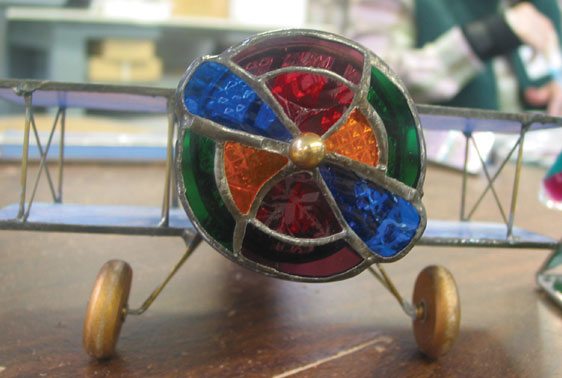
Airplane-themed Kaleidoscope
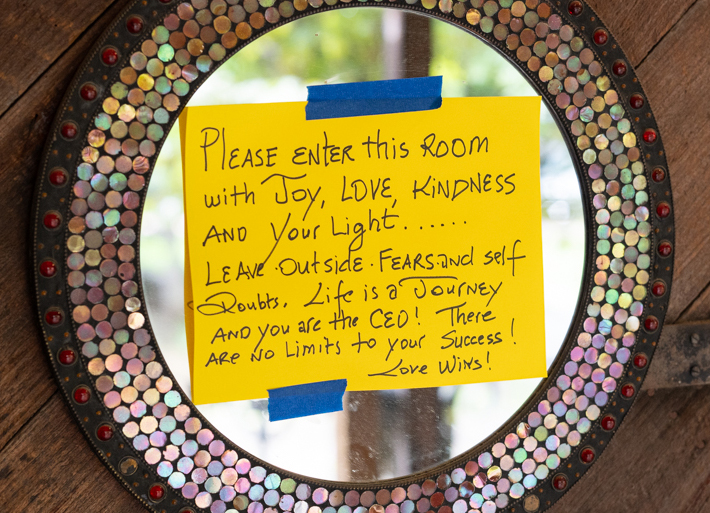
David’s Message on the Door of His Classroom
CP: One thing I’ve noticed in all the kaleidoscope class names and descriptions is it seems like there are profound philosophical undertones and a very whimsical, almost mystical feeling. You call your class “A Metaphor for Life,” can you talk about that?
DB: I see a kaleidoscope as a way of talking about life. Basically, what I try to get across to people is that you have four pieces that can make a scope and those four pieces reflect different aspects of our lives.
First, is the outer body, what people see first. In class, I have my students think about how people can look at our bodies and judge us. People can make judgments and do all kinds of horrible things because they just see the outer body, and sometimes that’s as far as they go. Some people go deeper, but a lot of people make a judgment and that’s as far as they go. You can do anything you can imagine to your scope’s outer body and that’s the first thing people see.
Next, is the eyepiece, which relates to how you perceive life. We look at our world and we see the world through our eyes. It’s up to us what we choose to see and that’s totally personal and very spiritual. You look in your kaleidoscope through an eye piece just like you look at your world.
At the end of the scope, you have an object chamber. What we put in our object chambers are like the things we want to see and put in our life. As a metaphor, you look through your eyes in life and you ask yourself: “What do I choose for me in life?” And that’s the object chamber, what you really choose to put there, it can be limitless or it could be very limited.
In a scope, you could literally have beads or shards of glass or beans or anything. I pose these questions to my students when we talk about our object chambers: “What are you planning to see in your life? Where do you want to go? What are your goals?” I try to show that it is limitless.
My favorite part of the metaphor, is the magic of the mirrors. You can have your outer body, your eye piece, and your object chamber, but it’s empty without the stuff that goes in the middle. In a kaleidoscope it’s the mirrors that make it magical. I say to my class, “That’s just like us. It’s that thing that shines in us.” We have an outer body and when you get in touch with those mirrors inside of yourself, or the ones you put in the scope, that’s what makes it very magical. I challenge people to think: “Who are you in relationship to each other and to yourself? What is it that makes that thing come alive inside of us (or a scope)?” It’s the mirrors that reflect and shine bright.
CP: Your classes are renowned for joy manifested through decoration, costume, and play. You are known as such a fearless whimsical figure around the Folk School, always bringing a lot of love and color and fun. Where does that come from and why is it important?
DB: Good question. I am expressing now what I wanted to do as a child, and it was not allowed. I knew from a very early age that’s who I was; I wanted to play dress-up. I was allowed to do some of it, but there were a lot of guards put against me. As I’ve gotten older, I’ve realized that when you are allowed to just play, play opens that part of you in your consciousness. It all frees me to be comfortable with me. It’s a courageous act, because it’s not easy all the time.
I found that the Folk School is a safe place to explore and play. When I have done different things or dressed up, especially in the Dining Hall, I will have some stranger come to me that I do not know and they say, “Thank you for being you, because you give me courage to be me.” I think that’s the most profound thing. I do agree with people, it gives other people permission to do it back and I think that’s the most powerful thing. We are so uptight in the world and I know it brings joy to people.
CP: Do you like being on a stage?
DB: It’s not about being on a stage, there’s a part of me that’s very shy. It’s about giving yourself permission to be whatever you want to be, to express yourself. I love colors and I love tutus and all sort of things because they’re really where I want to play. That’s where I want to explore.
CP: How is the Folk School a good place to explore this part of you?
DB: I can do it wherever on campus and people will smile. The most unusual people you would never expect will come up to me and say, “You just really make me be able to be me.” To me that’s just a gift and that just makes me happy.
It doesn’t always go all that well. To this day, my family will not tolerate it. They will tell me before I come, please don’t show up as an Easter Bunny. Please don’t do this or that. And that’s painful to me, but I’ll tell you, that’s where the Folk School has been good to me.
People send this creative energy to the Folk School in their minds before they even get here, almost like the object chamber in the kaleidoscope. People think, plan, and get excited about a course months before they even get here, and this ground just soaks up the good vibrations. I feel it as soon as I walk on campus, it’s just infused with creative energy.
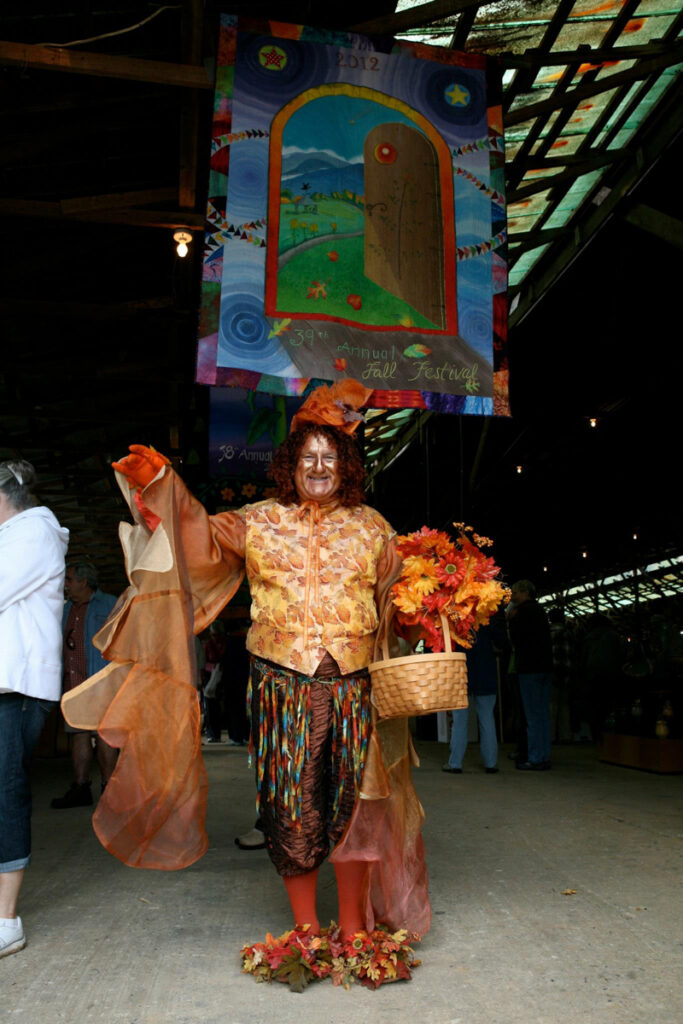
David as the “Spirit of Fall Festival”
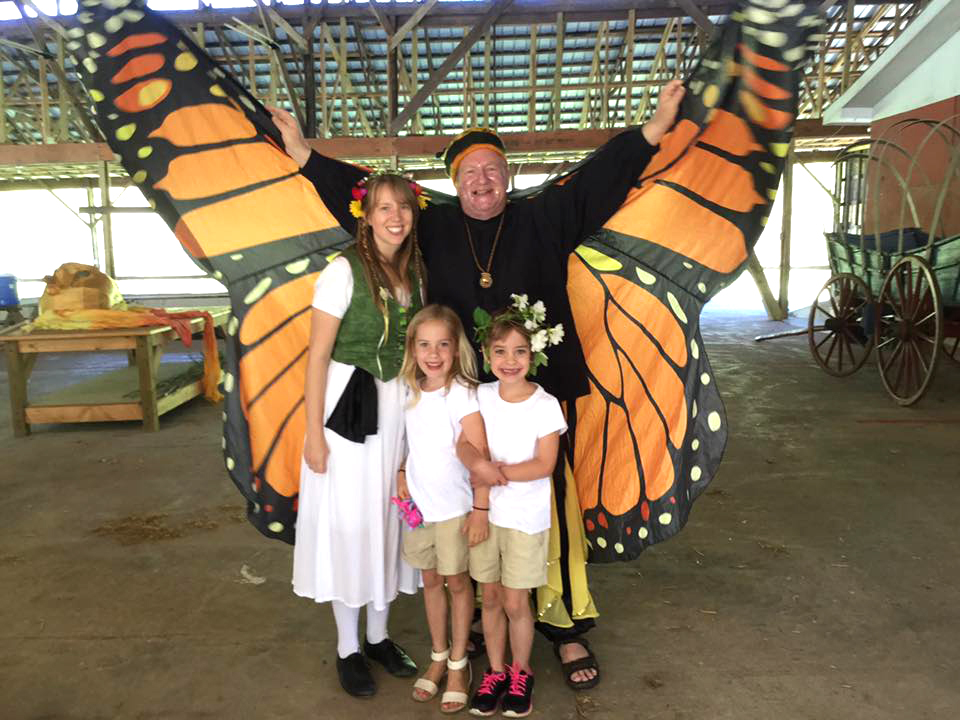
David as May Day Butterfly with Monica and Young Folk
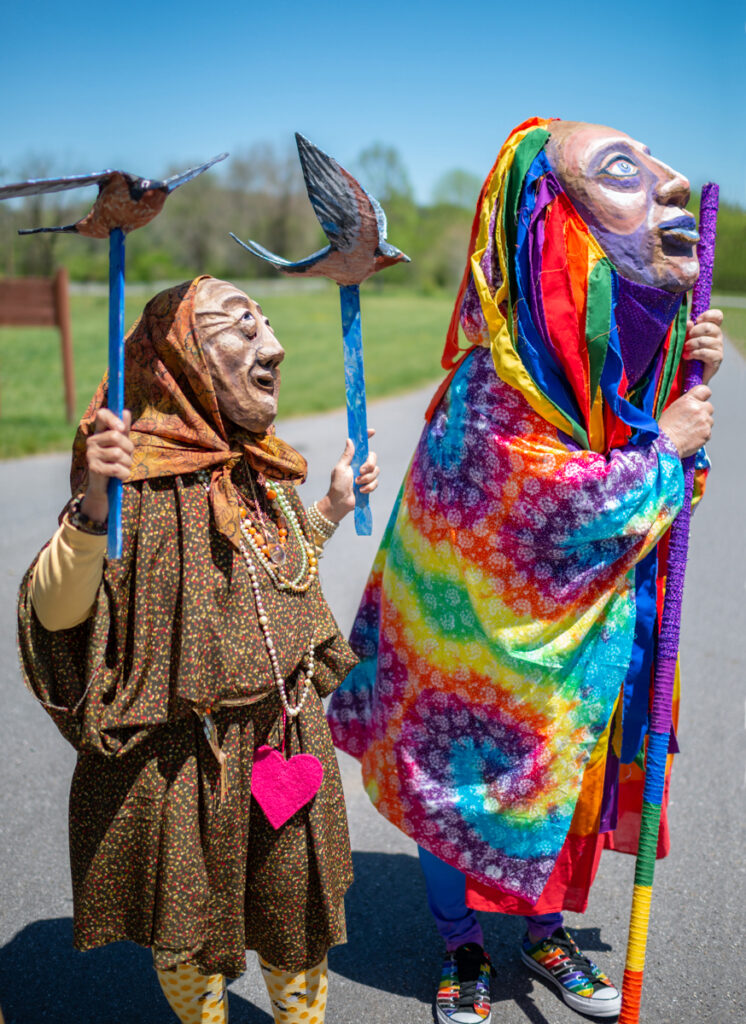
David as the Rainbow Spirit During May Day Parade
CP: Why do you like teaching at the Folk School?
This a school where you encourage everyone to succeed. Everyone’s gonna make it; it is not a school of competition. There are so many people who come to class and they’ll say, “I don’t know if I can do this.” And I get to say, “Oh we’ll be sure you can do this by the end of the week.”
I do a little ritual at the beginning of class. I don’t want to “spill the beans,” but a lot of the ritual has to do with the fact that I believe that every individual has a voice, and I don’t think they always have a chance to express it. I use the talking stick, and I tell the class when we do this, the time belongs to the person with the stick, and we’re going to give them that attention that they deserve for their life. They may say nothing, and that’s perfectly fine, but silence is their time.
Here at the Folk School, people come, and you have to start believing them from the very beginning and let them believe in themselves. It has made for marvelous energy together in the classroom. I also tell my students, “We are together at this moment, and there will never be another time like this, and there wasn’t a time like this before. This is unique to itself. We waited a lifetime for this to occur.” Thinking about the synchronicity of events, whether you are at the Folk School or anywhere else, it brings people together.
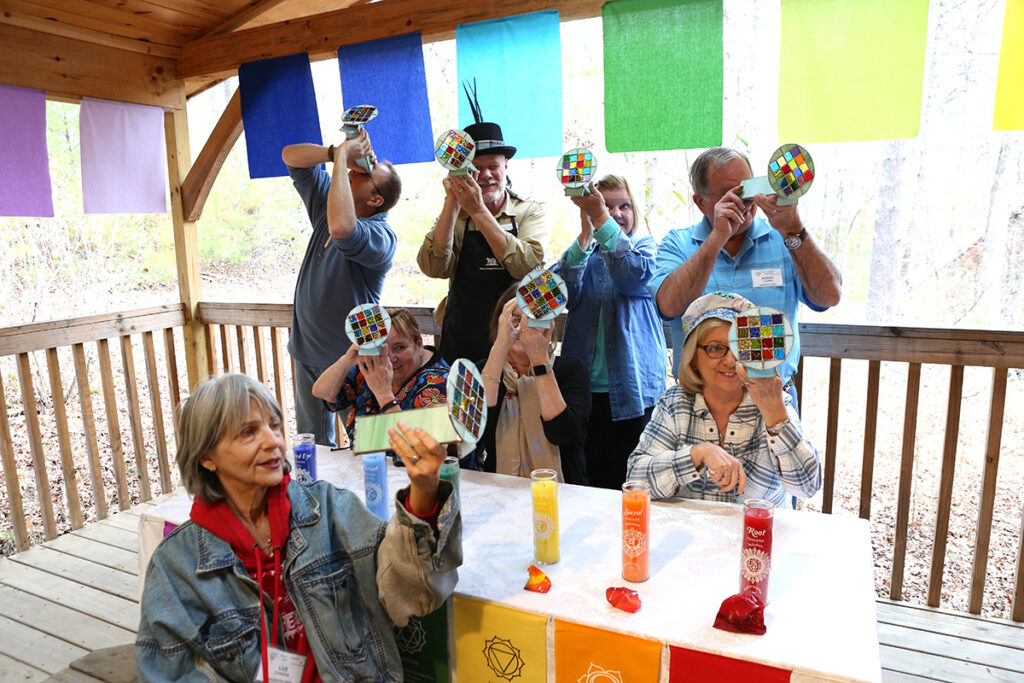
David’s Kaleidoscope Class
CP: I think about that too and how I came to the Folk School. From LA, I went all the way to Dare To Be Square in Seattle, and met Bob Dalsemer, and that’s how I found out about the Folk School. Since dance is very important to me, I also think about that idea of energy in the Community Room. When I stand in there, I think about all the thousands of dances that have taken place on that floor throughout the years, and it feels sacred and incredible.
DB: Exactly! You can’t help but be filled with the creative energy and vibration. You talking about your journey here reminds me that I am so thankful to my brother for that day I listened to him say, “I want to show you this place.” The place was here, and then the place found me through the circumstances.
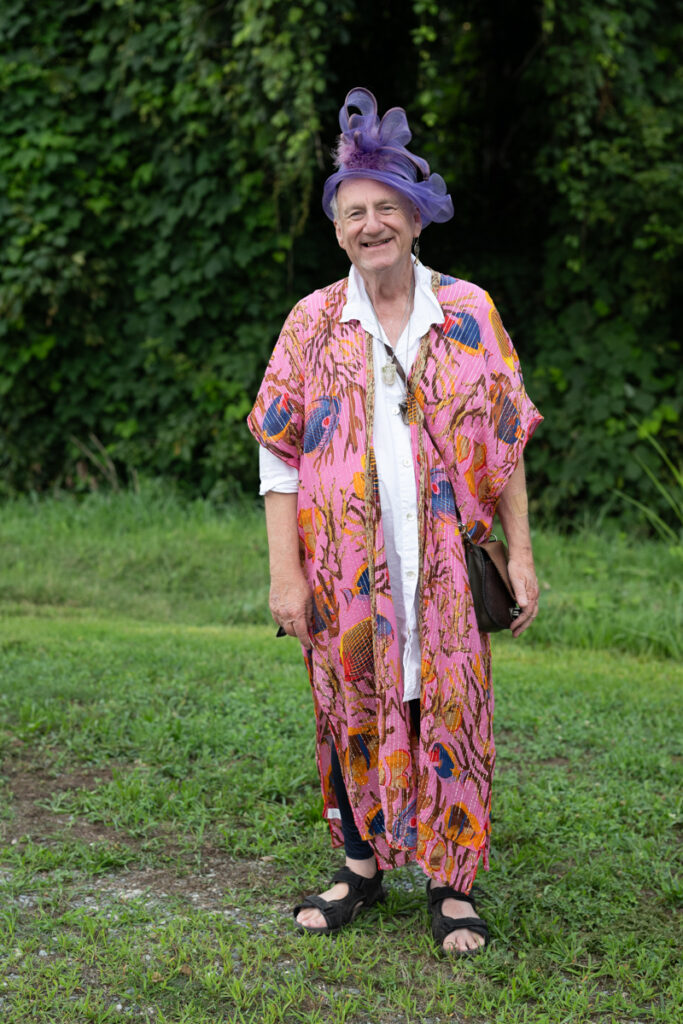
David by the Texana Community Center After Attending the Folk School Bridging & Bonding Panel Discussion
CP: How do you think art ties in with healing?
DB: I have had many people take my classes, and one of the most fascinating people I had, a psychotherapist who worked with adolescents, told me that she took the scope she made in my class, and she put it on her desk. A lot of people would come in very angry, but didn’t want to say anything. She would use the kaleidoscope as a tool to make a bridge to let something free. I think that’s what kaleidoscopes can do. They take people back to childhood. It’s like opening someone’s door to the place where we have play. Sometimes we forget to play.
CP: Speaking of healing, you are also a regular massage therapist at the Folk School. Can you talk a little about that?
DB: Oh absolutely! Massage is two people coming together as two vibrations, and as a therapist, you have to be very grounded. In my training body, mind, and spirit are all important. When you massage, you hold space for things to happen.
I’m fortunate enough to be in the Farmhouse where there is very beautiful energy in the living room. When I work there, people will express so many things that have to do with letting go. It’s an expression of their week here, an expression of how they got here, and what they’re going through in their outside life. They bring all that, and they just sort of release it, and they have that moment there to feel safe and to connect to that space. I create space for people to just let go and to be safe.
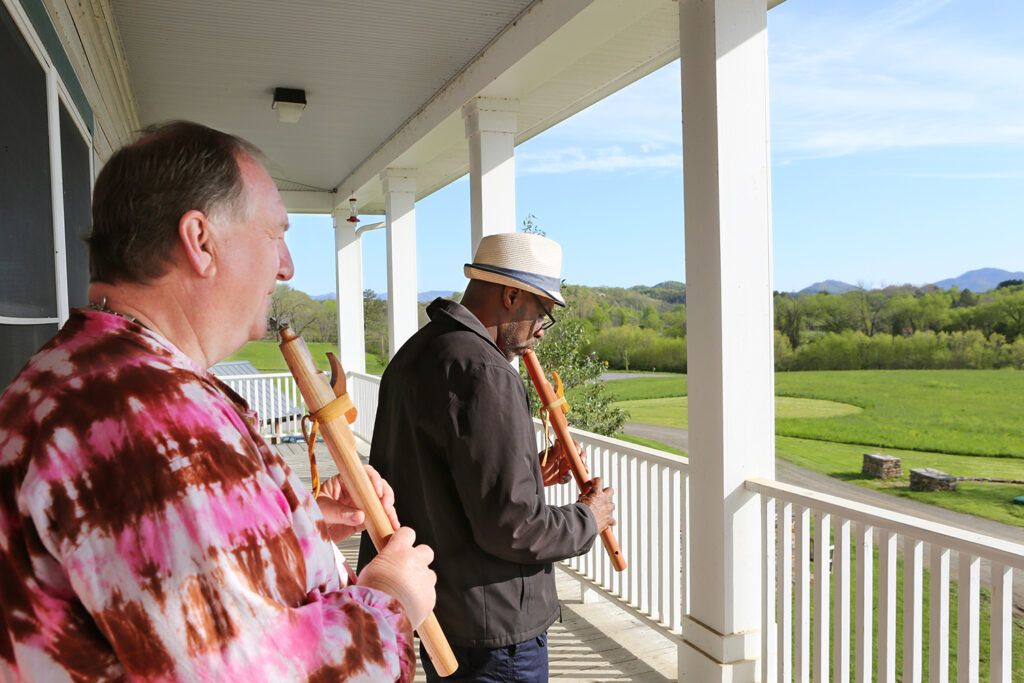
David and His Partner Preston Take a Native American Flute Class Together
CP: If you could time travel to any time, where would you go?
DB: Wow! That’s exciting! I would like to travel to the future, to where our vibration as people has elevated and to where everyone can just live and love and express themselves. Did you ever hear when you were growing up: “It’s the way it’s gonna be. You better get used to it, because it’s always been this way, and it’s always going to be this way.” I‘ve never agreed with that. I think there is a place where we can get to, where everyone can be doing what they want to do and be happy.
I think this place is ever-becoming, all we need is a shift in consciousness. It’s just like here at the Folk School! For example, when a student comes here at the beginning of the week, they don’t believe that they can make a dulcimer. By the end of the week. they’ve made a dulcimer and might wonder how they got from A to B? It’s the same shift. A student will shift their whole concept. When everyone on the planet does that, then that’s the place I want to time travel to. I love castles and stuff like that, but I don’t think it was fun living back then unless you were the queen or the king!
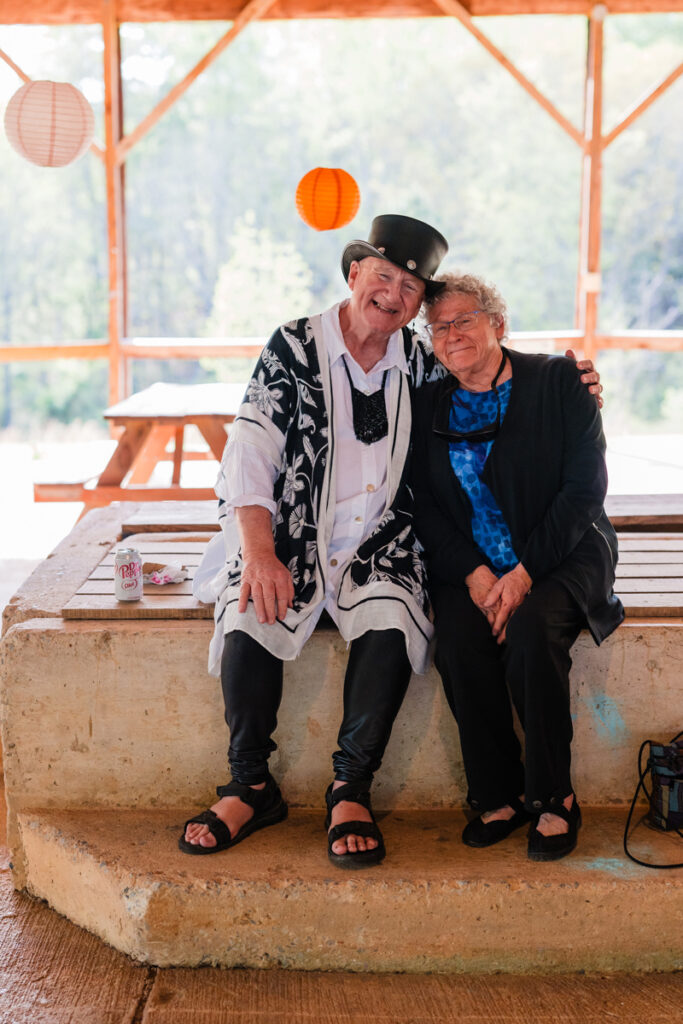
David and Close Friend Barbara Joiner in the Festival Barn
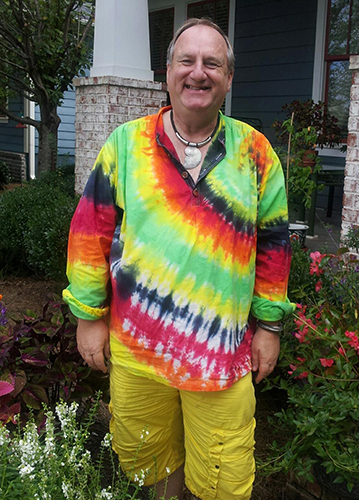
Rest in Peace David Baker We Miss You So Much and We Will All Strive to Carry on Your Message of Love at the Folk School
CP: What’s your favorite place on campus?
DB: That’s a hard question because there’s lots of them. Recently, the most magical place has been in between the Craft Shop and Davidson Hall by the new storytelling stage. There’s a swing and a little stream, and it’s just magical. It makes me feel great peace and safety to be there. If you go there, you will feel the magic. There are places like that all over. It’s nature.
CP: Do you have any advice to people reading?
DB: I’d like to say believe in yourself, even if you look and you can’t see what’s in front of you, just know there’s a way through. Believe, and just wait for the magic to occur, because it will come to you from every angle. Never give up because it’s all around to you. Just keep pushing through and just believe. Also, be grateful; your cup is full if you recognize it.




lecastleberry
Posted at 18:29h, 26 AugustThank you for sharing this great memory of David. A true spirit, a special individual and a forever friend. His spirit will remain at JCC even after all who knew him have joined him.